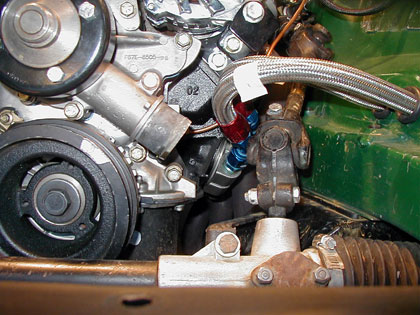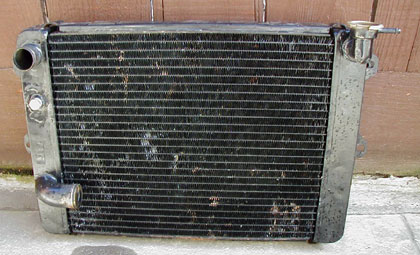Tiger 5.0 Conversion

An Article by Curtis Fisher
Sept., 2001
Page 4
Get the Plumber:
Since the water pump inlet is on the drivers side, you will have some major plumbing to route it to the passenger side radiator outlet. Or you can install your previous timing cover and water pump. At the time of decision, there were several newsgroup postings of two-pass or three pass radiator, water wetters, coolant flow rates, fan selections, shrouding, water pump alignments, alternator alignments, radiator types (fat core, aluminum, Ron Davis, and others). I decided to keep the original crate motor accessories and adapt radiator to accommodate. In retrospect, installing a passenger side inlet water pump is a far easier solution.

At the time of decision, two-pass radiator seemed desirable for cooling. I had to contend with more horsepower and the presented water pump. (in retrospect, weigh the options and time required) I chose to try adapting a drivers side inlet water reverse rotation water pump to this set up. I carefully measured the water pump inlet to steering shaft, the most critical distance. This distance is 2.125 inches. (this photo was taken through the grill without the radiator) I could not find a single radiator hose to exit the inlet and clear the steering and connect to the radiator. So I adapted two hoses to fit a custom elbow (this is shown in a previous picture). This was all done to accommodate the water pump. I could have saved time by buying a standard water pump to standard rotation.
Hindsight:
Later I realized how big that decision was. In keeping with the two pass radiator approach and drivers side waterpump inlet, I had the radiator converted to match installation needs. The result radiator is shown here. The radiator inlet is shown top left, outlet bottom left, fill/pressure cap top right, plug for sensor mid-left. This was ‘an experiment’ using my existing radiator. I was contemplating the newer aluminum radiators. I am still measuring results, it seems to work as noted below.

Installation was very straightforward after this. The radiator is the stock fat core radiator from the previous system which cooled very well. The approach attempted was to use a serpentine belt and an electric fan as needed. No engine fan or shroud. This worked marginally. Although it never overheated, the temperature would rise on warm days in stop and go traffic. Perhaps, I over watched the temperature gauge. I was accustomed to steady 190 temperature, and a rare excursion to 200. With no engine fan, the temperature would hold at 20 + mph drives, usually at 190. However in stop and go, it would quickly climb to 205-215. The electric fan would bring it below 200, but it was worrisome. I finally decided it was very bothersome and not as good as the previous system with engine fan. So I began to look for reverse rotation fans… there aren’t many.
 **
**


